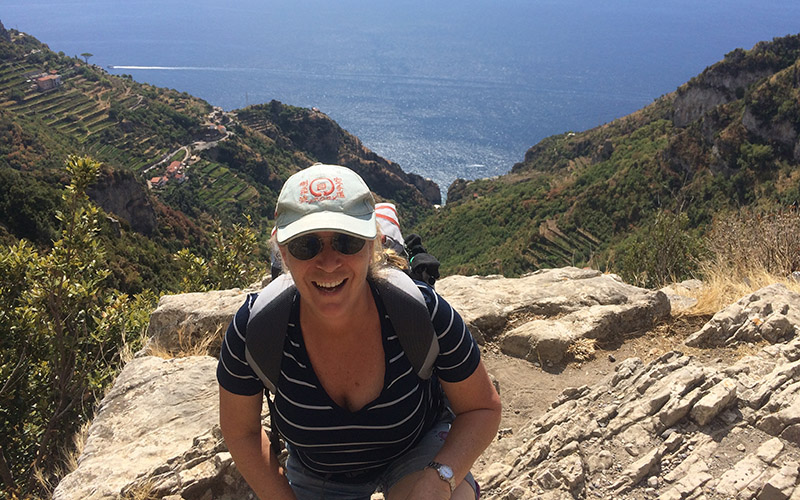The Amalfi coast consists of battered marble stairs that thread around and under houses and go up: irregular, steep, connecting across the winding roads and hundreds high, then a corner, and another hundred and a corner and a few hundred more until you collapse, exhausted at the top of the world with far more sea than you could ever view from the ground.
Everywhere is a walk down or up – hard on the knees but good for the heart, and what starts as breath talking surprises becomes the expectation: whitewashed houses built into outward leaning cliff faces, a ledge of rock holding an exquisitely proportioned church, a scrap of near vertical land terraced with lemons, a view that reaches from Capri along the whole stretch of the Amalfi Coast.
From a height, the towns are rustic and their history obvious, goods flowed down to the port for trade. Olives, figs, lemons, tomatoes. On this coast there is no flat land, so the little villages fill the crevices in the steep hills upwards from the sea. The stone steps of the original paths have remained, too steep to evolve into roads, and the narrow roads overlaid, following the contours, stuck into a crack of a cliff, best driven at speed in an Aston Martin with dark glasses and a movie star smile.
Close up, the towns are now a setting for tourists and the mishmash of joined houses clustering the port sell sandals and cool linen clothing, jewellery, pottery painted with lemons and sun hats to an international crowd. If your idea of heaven is a restaurant with a fine sea view and fresh basil, tomato and mozzarella on the menu, go to Positano, Amalfi, Praiano, Atrani, Minori, you’ll dine with the gods every day.
If you’re walking (do some hills before you go), take the Sunflower Guide and follow their descriptions of the paths, there is no detailed map that can guide you along the path in the direction of the single island and up the narrow pathway to the left of the church until you find the wooden fence by the olive grove. You need that level of detail and it helps, as you’re climbing, to imagine a future life when your job is a full time checker of Sunflower Travel Guides. We didn’t see anyone else with packs walking from town to town – busses are everywhere, but I would do the same again. Felt like a pilgrim.
Amalfi to Ravello is at least 1500 steps with long steep paths. Most people take the bus but the very few of us on the path recognised fellow heroes. There’s a beautiful pause when you reach the shelf that holds the gardens of the the Villa Cimbrone on the edge (very edge) of Ravello. A step further and you’re flying. Ravello is an impressive, established town that looks, from the coast, like a couple of houses, but the town unfolds as you crest the peak to a thriving hub with several large churches, a sunny piazza and busy streets. Ghosts of Virginia Wolf, Gore Vidal, DH Lawrence, Wagner give a good, boho vibe.
We kept walking inland, up yet another 300m staircase when we were already on top of the world, and skirted the Lattari mountains on a mule track back to Amalfi, inside the deep limestone bowl of towering cliff faces.
The most famous track, with tourists to match, is the Path of the Gods, which starts with a bus trip up the cliffs to Bomerano and ends, several gods later, in a million steps (not really a million) down to Positano.
My absolute number one walk was from Colle di Fontanelle to Sorento via Sant’ Agata, a glorious ramble on the rugged land’s edge where cliff meets high pasture and terraces, right across the peninsula with occasional views on both sides and no other tourists. The path led through a couple of small towns where kids played football in the square and ancient three wheeled vehicles laboured up the hills.
This wasn’t on my bucket list but I am ticking it off anyway. You feel the Gods all across this region, but on this track “ZEUS WAS HERE” is carved into the stone.




